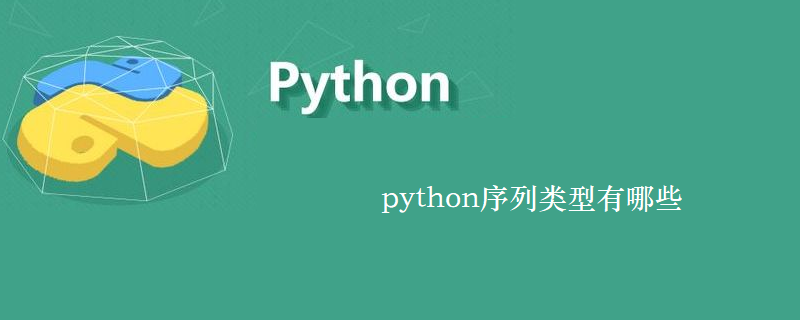Home > Article > Backend Development > What are the python sequence types?
What are the sequence types in python? What is a sequence type in Python? Learn more about it in this article.

Sequence: character, list, tuple
All sequences support iteration
Sequence Represents an ordered collection of objects whose index is a non-negative integer
Characters and tuples belong to immutable sequences, and lists are mutable
1)Characters
String literal: Put the text in single quotes, double quotes or triple quotes;
' '' '''
>>> str1 = ' hello, fanison '
>>> type(str1)
str
If you want to use unicode encoding, use the character u before the character to identify it
>>> str2 = u'你好,fanison'
>>> type(str2)
unicode
Documentation string: If the first statement of a module, class or function is one character, the string becomes the documentation string and can be referenced using the __doc__ attribute;
Example:
>>> def printName():
"the function is print hello"
print 'hello'
>>> printName.__doc__ operator:
# S [i] Return to a sequence element I
slicing computing s [i: j] Return to one Slicing
Extended slicing operator s[i:j:stride]
Example:
>>> str3 = 'hello,fanison'
>>> str2[0:]
'hello,fanison' 返回所有元素
>>> str2[0:7]
'hello,f' 返回索引7之前的所有元素
>>> str2[0:7:2]
'hlof' 返回从索引0到6内步径为2的元素,即隔一个取一个
>>> str2[7:0:-2]
'a,le' 从索引7处倒着隔一个取一个取到索引1处
>>> str2[-4:-1]
'iso' 从索引-4处取到-2处
>>> str2[-4::-1]
'inaf,olleh' 从-4处到开始处倒着取Note:
Step If it is positive, it means that the index is taken from small to large i 476ce3aaf1c48df0d3c8595e91a938ea j
Supported Operations:
Indexing, slicing, min(), max(), len(), etc.
len(s) The number of elements in s
min (s) s minimum value
Max (s) s) The maximum value of
## Support method: S.index (SUB [,start [,end]]) Find the position where the specified string sub first appears S.upper() Convert a string to uppercase form S.lower() one String into a lowercase form # S.Join (T) uses S as a string in the separatist connection sequence T
>>> l1 = list(str1)
>>> l1
['h', 'e', 'l', 'l', 'o', ',', 'f', 'a', 'n', 'i', 's', 'o', 'n']
>>> ''.join(l1)
'hello,fanison' 使用空字符作为分隔符连接列表l1
S.replace(old, new[, count]) 替换一个字符串
>>> str1.replace('fan','FAN')
'hello,FANison' Note: ## Use help () to get Its help
>>> help(str.join)
2) List
List: Container Type
. Modify
to modify the specified index element, modify the specified shard, delete the statement, the built -in method
##
>>> list1 = [ 1,2,3,'x','n' ]
>>> list1[1]=56
>>> print list1
[1, 56, 3, 'x', 'n']
>>> list1[1:3]=[] 会删除索引1到索引3之前的元素
>>> print list1
[1, 'x', 'n']
>>> del(list1[1]) 使用del函数删除list索引为1的元素
>>> print list1
[1, 'n'] Note: ## Because support the original modification of the original place , Will not change the memory location, you can use ID () to view its location change
Built
## L.append(object) Append a new element to the end of L ’s . Add a merged list (the contents of the second list will be appended to the end as a single element) >>> l1 = [ 1,2,3 ]
>>> l2 = [ 'x','y','z']
>>> l1.append(l2)
>>> l1
[1, 2, 3, ['x', 'y', 'z']] 使用append方法会以其原有存在形式追加
>>> l1 = [ 1,2,3 ]
>>> l1.extend(l2)
>>> l1
[1, 2, 3, 'x', 'y', 'z'] 注意两种增加的区别 L.pop ([Index]) Return the element index and remove it from the list. The element that is key >>> l1 = [ 'x',2,'abc',16,75 ]
>>> l1.pop(2) pop方法是按索引移除
'abc'
>>> l1
['x', 2, 16, 75]
>>> l1.remove(16) remove方法是按值移除
>>> l1
['x', 2, 75] to ’ s ’ s ’ s ’ s to ’ t ’ ’ ’ ’ s ‐ to ‐ ‐ ‐‐ ‐‐ ‐‐n-key, L.insert(index, object) 在索引index处插入值
>>> l1.insert(1,'abc')
>>> l1
['x', 'abc', 2, 75]L.sort() 排序
L.reverse() 逆序
>>> l1.sort()
[2, 75, 'abc', 'x']
>>> l1.reverse()
['x', 'abc', 75, 2]
l1 + l2: 合并两个列表,返回一个新的列表;不会修改原列表;
>>> l1 = [ 1,2,3]
>>> l2 = [ 'x','y','z']
>>> l1 + l2
[1, 2, 3, 'x', 'y', 'z']
l1 * N: 把l1重复N次,返回一个新列表;
>>> l1 * 3
[1, 2, 3, 1, 2, 3, 1, 2, 3] 使用id()查看是否生成新列表成员关系判断字符:
in 用法: item in container
not in item not in container
>>> l1 = [ 'x','y',3 ]
>>> 'y' in l1
True
>>> 'x' not in l1
False
列表解析:[]
列表复制方式:
浅复制:两者指向同一内存对象
>>> l1 = [ 1,2,3,4 ]
>>> l2 = l1
>>> id(l1) == id(l1)
True 可以看出两者内存地址相同
>>> l1.append('x')
>>> print l1
[ 1,2,3,4,'x' ]
>>> print l2
[ 1,2,3,4,'x' ]深复制:两者指向不同内存对象
1)导入copy模块,使用deepcoop方法
>>> import copy
>>> l3 = copy.deepcopy(l1)
>>> id(l3) == id(l1)
False 地址不同
2)复制列表的所有元素,生成一个新列表
>>> l4 = l1[:]
>>> print l4
[ 1,2,3,4,'x' ]
>>> l1.append(6)
>>> print l1
[ 1,2,3,4,'x',6 ] l1改变
>>> print l4
[ 1,2,3,4,'x' ] l4不变3)元组
表达式符号:()
容器类型
任意对象的有序集合,通过索引访问其中的元素,不可变对象,长度固定,异构,嵌套
常见操作:
>>> t1 = ( 1,2,3,'xyz','abc')
>>> type(t1)
tuple
>>> len(t1)
5
>>> t2 = () 定义一个空元组
>>> t3 = ( , )
SyntaxError: invalid syntax 报错:使用逗号分隔的条件是最少要有一个元素
(1,)
>>> t1[:]
( 1,2,3,'xyz','abc' )
>>> t1[1:]
(2, 3, 'xyz', 'abc')
(1,2)
>>> t1[1:4]
(2, 3, 'xyz')
>>> t4 = 'x',1,'yz',45,[2,4,6] 注意!!!这样也可以生成元组
>>> t4
('x', 1, 'yz', 45, [2, 4, 6])t1 + t4: 合并两个元组,返回一个新的元组;不会修改原元组;
>>> t1 + t4
(1, 2, 3, 'xyz', 'abc', 'x', 1, 'yz', 45, [2, 4, 6])
t1 * N: 把l1重复N次,返回一个新元组;
>>> t1 * 3
(1, 2, 3, 'xyz', 'abc', 1, 2, 3, 'xyz', 'abc', 1, 2, 3, 'xyz', 'abc')成员关系判断
in
not in
注意:
虽然元组本身不可变,但如果元组内嵌套了可变类型的元素,那么此类元素的修改不会返回新元组;
例:
>>> t4 = ('x', 1, 'yz', 45, [2, 4, 6])
>>> id(t4)
44058448
>>> t4[4]
[2, 4, 6]
>>> t4[4].pop() 弹出列表内一个元素
6
>>> print t4[4]
[2, 4]
>>> print t4
('x', 1, 'yz', 45, [2, 4])
>>> id(t4)
44058448 由此可见,对元组内列表内的修改也会使元组发生改变,没有返回新元组The above is the detailed content of What are the python sequence types?. For more information, please follow other related articles on the PHP Chinese website!